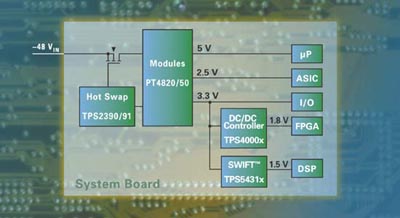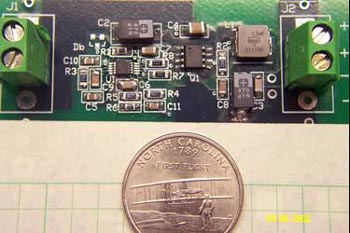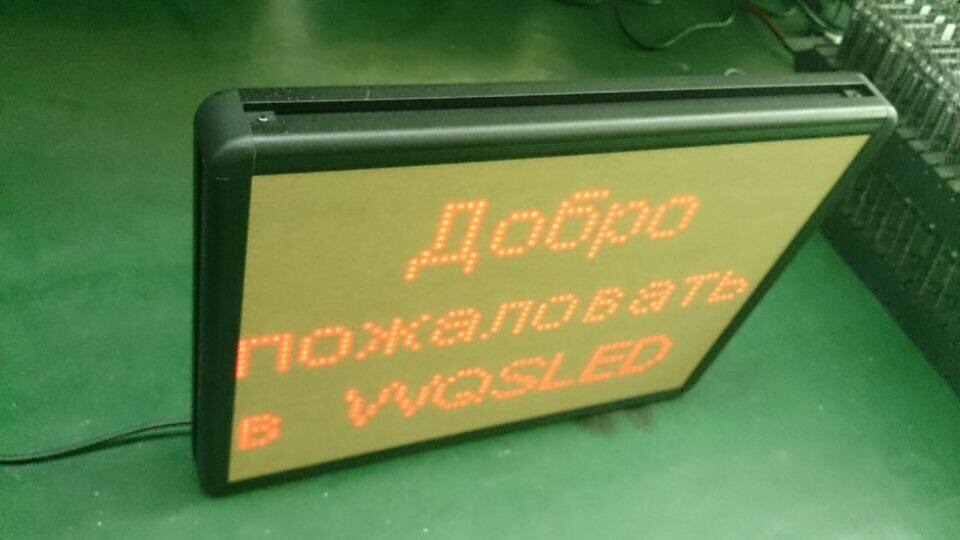With so many different choices of POL converters, system designers must evaluate some basic and often conflicting trade-offs. The trade-offs made were all around time to market, ease of use, cost, efficiency, and form factor. Currently, system designers have three basic POL converters to choose from: plug-in modules, pulse-width-modulation (PWM) converters with integrated power MOSFETs, and PWM controllers designed to drive external MOSFETs.
The plug-in module is a complete power supply designed, tested and verified by the module supplier. Users simply plug the module into the system board. The DC/DC converter is a monolithic controller with an integrated FET. This type of solution simplifies the design and board layout by eliminating the need to select external FETs, and is generally easier to compensate. The PWM controller is the most flexible option because it uses an external FET that can be optimized for a specific application.
In general, designers using a modular POL solution will be able to achieve the fastest design time, so that products can be available in the shortest time possible. In other cases, the need for ease of use and compact designs heralds the adoption of a discrete solution with an integrated FET converter. Still other applications may have extremely high requirements for flexibility and cost, which requires the use of a discrete integrated circuit (IC) controller with an external power switch.
Numerous applications in the non-isolated DC/DC IC market use Distributed Power Architecture (DPA). A DC bus (typically -48V) is distributed along the backplane in a large rack. Each rack contains many cards, each card has a variety of DC voltage requirements. A common system architecture for a dedicated card includes an isolated DC/DC module with a -48V to main card level voltage (3.3V, 2.5V, etc.). This architecture requires the use of an auxiliary non-isolated POL power supply. The DPA card contains a variety of components (such as DSPs, memory modules, FPGAs, and core and I/O logic devices) that require several different POL supply voltages (under 0.5A to 15A current conditions) 2.5V, 1.2V, 1.0V, and 0.8V). In this market, the important features required for DC/DC converters are ease of use, compactness (frequently considering dual output power and three output power supplies), high efficiency, and low price.
Figure 1 shows a typical plug-in distributed power solution that feeds the card with a distributed bus voltage (here -48V). The first requirement is usually hot swap protection. When a printed circuit card is plugged into a live backplane, the bulk capacitance on the circuit board draws large transient currents from the rack power supply. If some inrush current protection is not used, these high currents can damage the connector pins and PCB traces. Furthermore, the resulting voltage spikes can also damage the active and passive components on the board and cause interference with sensitive components on other cards in the system.

Figure 1: Typical Card Level Distributed Power Solution
Let's take a hot-swap power management IC (such as the TPS2390/91) developed to avoid these common problems as an example. These ICs use an external N-channel MOSFET and a sense element to provide closed-loop control of the current supplied to the system's card during hot-swap.
The next step in the conversion process is an isolated power supply. Most DPA systems require electrical isolation between the DPA bus voltage and a dedicated card. This isolation is implemented for safety and return control considerations to avoid the formation of current loops.
For isolated power supplies, system designers can choose to build a discrete card-level solution. Although this may be a more cost-effective solution in high-volume applications, the use of a fully tested and tested off-the-shelf module can often significantly reduce the time to market for a design. In addition to design time savings, the use of a modular, isolated power supply also greatly simplifies the security agent approval process.
Fully isolated module power supply for maximum flexibility and ease of use in -48V applications. For example, the PT4820/50 module provides three low-voltage outputs, allowing users to meet most board-level DC/DC requirements with just one device. One of the great advantages of a three-output power supply is its ability to directly control the start and stop power sequencing, which has made this often vexing problem solved.
However, it is not uncommon for a board to require six (or more) DC-POL voltages on one card. Even a three-output isolated power supply is likely to need assistance from an additional POL converter. For board-level power designers, synchronous DC/DC converters are another valuable tool. By integrating power FETs with PWM controllers, designers have implemented a design that is extremely compact and easy to use. As shown in Figure 1, in the SWIFTTM series of synchronous DC/DC converters, a thermally enhanced package called PowerPADTM enables increased efficiency without the need for an external heat sink. The ultimate solution to the DC/DC converter problem is often due to the high efficiency of the DC/DC controller. The conflicting system requirements of cost, power, efficiency, and board area often simply require the use of an external FET controller to increase flexibility. In order to effectively eliminate the conduction in the synchronous rectifier MOSFET body diode, a new technology called Predictive Gate DriveTM can be used to optimize the turn-off and turn-on time of the external MOSFET. This technology can reduce power consumption in synchronous FETs by up to 40%, resulting in increased efficiency and reliability, and reduced overall system cost.
Figure 2 shows a complete board design for a 600kHz, 3.3V to 1.2V supply. The entire design occupies less than 1 square inch of board space while delivering a load current of up to 5A. By adjusting the choice of external MOSFETs, this efficiency has exceeded 90% of the design scheme will be able to provide higher efficiency and/or load current. It also has fault protection and startup features.

Figure 2: Synchronous DC/DC Power Supply Based on TPS40003
In the face of all these complex selection criteria, today's system designers must have a comprehensive library of DC/DC converter tools. Because the systems are different, no solution can be suitable for all applications. The key to success is how to find a difficult balance between many conflicting design priorities. This often requires a combination of solutions, even on a dedicated circuit board. Providing higher flexibility is not only a challenge faced by system designers, but also a topic that cannot be avoided by power supply solution providers.
Technical features
1. Preeminent effects: Clear and stable pictures without distortion and disturbance.
2.
quality: adopting first-class chips and wafers imported from abroad
3. Flexible form: continuity, overlying, combination of dynamic and static playing, various effects include rolling moving, typewriting, gradual changing and so on
4. off-line running function: adopting the monolithic design technology and computer string communication way, which can operate in off-line state setting the dates and revising a data via the telephone line
Technical Parameters
Multi language: English/Spanish/Russia/Inter.char.set-..
1)High Brightness, user can change the advertising words whatever you want, easy and convenient in operation, more attactive compared with traditional banner.
2) The led moving sign display supports many kinds of languages and characters.
3) A lot of lively animation icons are built-in. 50 and more action effects for user option; Different brightness can be adjusted in software.
4) Time clock format, support date, countdown and any other odditional functions like temperature and humidity. Voltage input: 220v or110v.
5) led moving sign display Structure: well appreance frame, professional pendents, standard connectors and other accessories.
Usage
Service propaganda in finances, post offices, telecom, commerce, hospitals, sports stadiums
Policies and decrees issued from government organizations
Instructions, guidance and information issuance in airports and railways
Our service
1.Your inquiry related to our products or price will be replied in 24hrs
2.OEM&ODM,any your customized lightings we can help you to design and put into product
3.Protection of your sales area,ideas of design and all your private information
4.Top Quality+Reasonable Price+Responsible After Service=Successful & Win
5.Produce all kinds of Pitch: P4.75, P7.62, P10, P12, P16, P20, P25, P31.25...

Indoor Single Color LED Display
Indoor Single Color Led Display,Led Panel Screen,Single Led Display,Single Color Led Message Display
Shenzhen Joy LED Display Co., Ltd. , https://www.joe-led.com